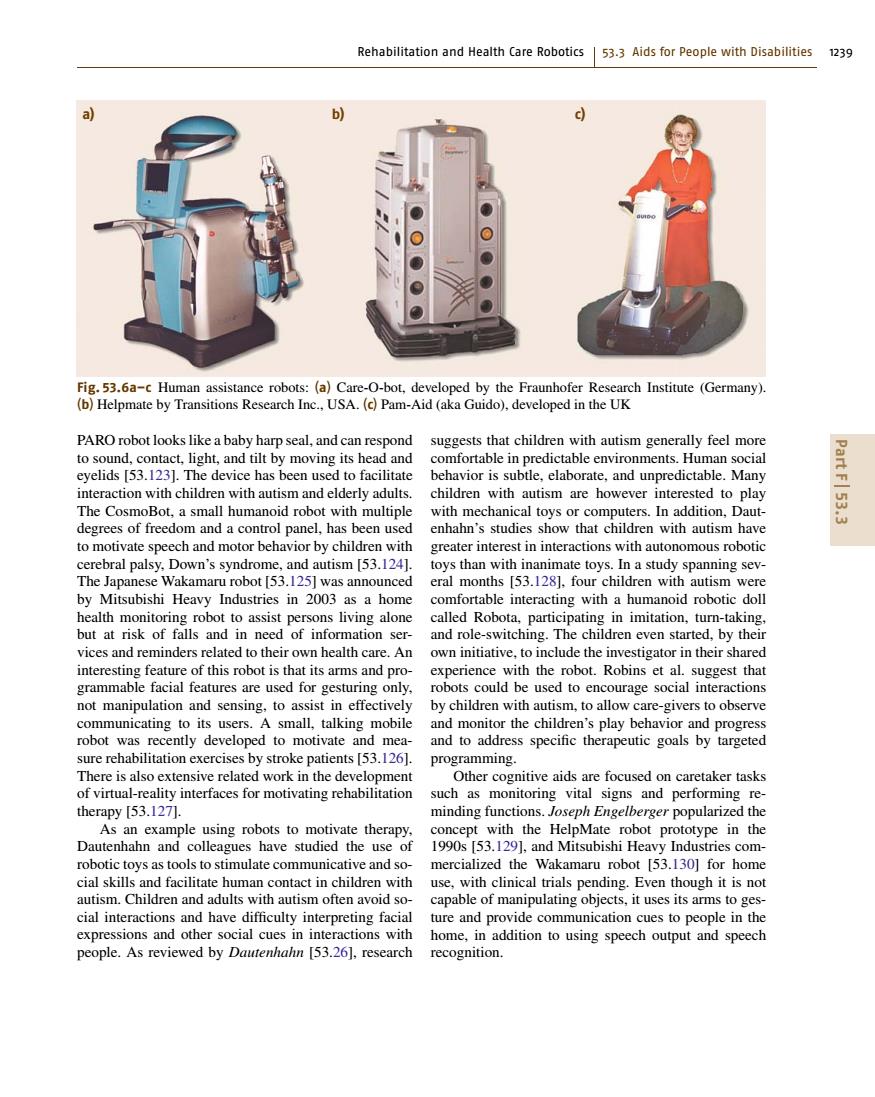正在加载图片...

Rehabilitation and Health Care Robotics 53.3 Aids for People with Disabilities 1239 b) Fig.53.6a-c Human assistance robots:(a)Care-O-bot,developed by the Fraunhofer Research Institute (Germany). (b)Helpmate by Transitions Research Inc.,USA.(c)Pam-Aid(aka Guido),developed in the UK PARO robot looks like a baby harp seal,and can respond suggests that children with autism generally feel more to sound,contact,light,and tilt by moving its head and comfortable in predictable environments.Human social Part eyelids [53.123].The device has been used to facilitate behavior is subtle,elaborate,and unpredictable.Many interaction with children with autism and elderly adults.children with autism are however interested to play The CosmoBot,a small humanoid robot with multiple with mechanical toys or computers.In addition,Daut- w degrees of freedom and a control panel,has been used enhahn's studies show that children with autism have to motivate speech and motor behavior by children with greater interest in interactions with autonomous robotic cerebral palsy,Down's syndrome,and autism [53.124]. toys than with inanimate toys.In a study spanning sev- The Japanese Wakamaru robot [53.125]was announced eral months [53.1281.four children with autism were by Mitsubishi Heavy Industries in 2003 as a home comfortable interacting with a humanoid robotic doll health monitoring robot to assist persons living alone called Robota,participating in imitation,turn-taking. but at risk of falls and in need of information ser-and role-switching.The children even started,by their vices and reminders related to their own health care.An own initiative,to include the investigator in their shared interesting feature of this robot is that its arms and pro-experience with the robot.Robins et al.suggest that grammable facial features are used for gesturing only,robots could be used to encourage social interactions not manipulation and sensing,to assist in effectively by children with autism,to allow care-givers to observe communicating to its users.A small,talking mobile and monitor the children's play behavior and progress robot was recently developed to motivate and mea-and to address specific therapeutic goals by targeted sure rehabilitation exercises by stroke patients [53.126].programming. There is also extensive related work in the development Other cognitive aids are focused on caretaker tasks of virtual-reality interfaces for motivating rehabilitation such as monitoring vital signs and performing re- therapy [53.127]. minding functions.Joseph Engelberger popularized the As an example using robots to motivate therapy, concept with the HelpMate robot prototype in the Dautenhahn and colleagues have studied the use of 1990s [53.129],and Mitsubishi Heavy Industries com- robotic toys as tools to stimulate communicative and so-mercialized the Wakamaru robot [53.130]for home cial skills and facilitate human contact in children with use,with clinical trials pending.Even though it is not autism.Children and adults with autism often avoid so-capable of manipulating objects,it uses its arms to ges- cial interactions and have difficulty interpreting facial ture and provide communication cues to people in the expressions and other social cues in interactions with home,in addition to using speech output and speech people.As reviewed by Dautenhahn [53.261,research recognition.Rehabilitation and Health Care Robotics 53.3 Aids for People with Disabilities 1239 a) b) c) Fig. 53.6a–c Human assistance robots: (a) Care-O-bot, developed by the Fraunhofer Research Institute (Germany). (b) Helpmate by Transitions Research Inc., USA. (c) Pam-Aid (aka Guido), developed in the UK PARO robot looks like a baby harp seal, and can respond to sound, contact, light, and tilt by moving its head and eyelids [53.123]. The device has been used to facilitate interaction with children with autism and elderly adults. The CosmoBot, a small humanoid robot with multiple degrees of freedom and a control panel, has been used to motivate speech and motor behavior by children with cerebral palsy, Down’s syndrome, and autism [53.124]. The Japanese Wakamaru robot [53.125] was announced by Mitsubishi Heavy Industries in 2003 as a home health monitoring robot to assist persons living alone but at risk of falls and in need of information services and reminders related to their own health care. An interesting feature of this robot is that its arms and programmable facial features are used for gesturing only, not manipulation and sensing, to assist in effectively communicating to its users. A small, talking mobile robot was recently developed to motivate and measure rehabilitation exercises by stroke patients [53.126]. There is also extensive related work in the development of virtual-reality interfaces for motivating rehabilitation therapy [53.127]. As an example using robots to motivate therapy, Dautenhahn and colleagues have studied the use of robotic toys as tools to stimulate communicative and social skills and facilitate human contact in children with autism. Children and adults with autism often avoid social interactions and have difficulty interpreting facial expressions and other social cues in interactions with people. As reviewed by Dautenhahn [53.26], research suggests that children with autism generally feel more comfortable in predictable environments. Human social behavior is subtle, elaborate, and unpredictable. Many children with autism are however interested to play with mechanical toys or computers. In addition, Dautenhahn’s studies show that children with autism have greater interest in interactions with autonomous robotic toys than with inanimate toys. In a study spanning several months [53.128], four children with autism were comfortable interacting with a humanoid robotic doll called Robota, participating in imitation, turn-taking, and role-switching. The children even started, by their own initiative, to include the investigator in their shared experience with the robot. Robins et al. suggest that robots could be used to encourage social interactions by children with autism, to allow care-givers to observe and monitor the children’s play behavior and progress and to address specific therapeutic goals by targeted programming. Other cognitive aids are focused on caretaker tasks such as monitoring vital signs and performing reminding functions. Joseph Engelberger popularized the concept with the HelpMate robot prototype in the 1990s [53.129], and Mitsubishi Heavy Industries commercialized the Wakamaru robot [53.130] for home use, with clinical trials pending. Even though it is not capable of manipulating objects, it uses its arms to gesture and provide communication cues to people in the home, in addition to using speech output and speech recognition. Part F 53.3